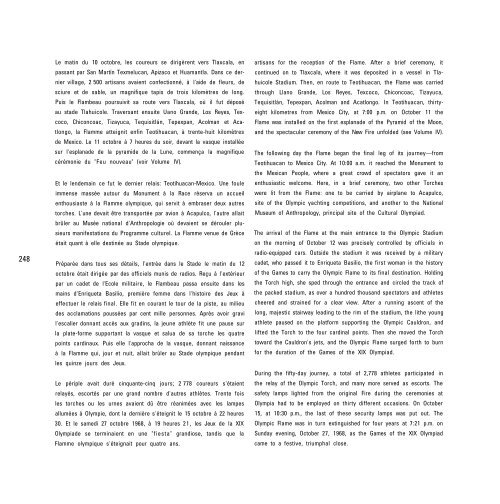Mexico City Olympic Games Official Report ... - LA84 Foundation
Mexico City Olympic Games Official Report ... - LA84 Foundation
Mexico City Olympic Games Official Report ... - LA84 Foundation
You also want an ePaper? Increase the reach of your titles
YUMPU automatically turns print PDFs into web optimized ePapers that Google loves.
248<br />
Le matin du 10 octobre, les coureurs se dirigèrent vers Tlaxcala, en<br />
passant par San Martín Texmelucan, Apizaco et Huamantla. Dans ce der-<br />
nier village, 2 500 artisans avaient confectionné, à l'aide de fleurs, de<br />
sciure et de sable, un magnifique tapis de trois kilomètres de long.<br />
Puis le Flambeau poursuivit sa route vers Tlaxcala, où il fut déposé<br />
au stade Tlahuicole. Traversant ensuite Uano Grande, Los Reyes, Tex-<br />
coco, Chiconcoac, Tizayuca, Tequisitlán, Tepexpan, Acolman et Aca-<br />
tlongo, la Flamme atteignit enfin Teotihuacan, à trente-huit kilomètres<br />
de <strong>Mexico</strong>. Le 11 octobre à 7 heures du soir, devant la vasque installée<br />
sur l'esplanade de la pyramide de la Lune, commença la magnifique<br />
cérémonie du "Feu nouveau" (voir Volume IV).<br />
Et le lendemain ce fut le dernier relais: Teotihuacan-<strong>Mexico</strong>. Une foule<br />
immense massée autour du Monument à la Race réserva un accueil<br />
enthousiaste à la Flamme olympique, qui servit à embraser deux autres<br />
torches. L'une devait être transportée par avion à Acapulco, l'autre allait<br />
brûler au Musée national d'Anthropologie où devaient se dérouler plu-<br />
sieurs manifestations du Programme culturel. La Flamme venue de Grèce<br />
était quant à elle destinée au Stade olympique.<br />
Préparée dans tous ses détails, l'entrée dans le Stade le matin du 12<br />
octobre était dirigée par des officiels munis de radios. Reçu à l'extérieur<br />
par un cadet de l'Ecole militaire, le Flambeau passa ensuite dans les<br />
mains d'Enriqueta Basilio, première femme dans l'histoire des Jeux à<br />
effectuer le relais final. Elle fit en courant le tour de la piste, au milieu<br />
des acclamations poussées par cent mille personnes. Après avoir gravi<br />
l'escalier donnant accès aux gradins, la jeune athlète fit une pause sur<br />
la plate-forme supportant la vasque et salua de sa torche les quatre<br />
points cardinaux. Puis elle l'approcha de la vasque, donnant naissance<br />
à la Flamme qui, jour et nuit, allait brùler au Stade olympique pendant<br />
les quinze jours des Jeux.<br />
Le périple avait duré cinquante-cinq jours; 2 778 coureurs s'étaient<br />
relayés, escortés par une grand nombre d'autres athlètes. Trente fois<br />
les torches ou les urnes avaient dû être réanimées avec les lampes<br />
allumées à Olympie, dont la dernière s'éteignit le 15 octobre à 22 heures<br />
30. Et le samedi 27 octobre 1968, à 19 heures 21, les Jeux de la XIX<br />
Olympiade se terminaient en une "fiesta" grandiose, tandis que la<br />
Flamme olympique s'éteignait pour quatre ans.<br />
artisans for the reception of the Flame. After a brief ceremony, it<br />
continued on to Tlaxcala, where it was deposited in a vessel in Tla-<br />
huicole Stadium. Then, en route to Teotihuacan, the Flame was carried<br />
through Llano Grande, Los Reyes, Texcoco, Chiconcoac, Tizayuca,<br />
Tequisitlán, Tepexpan, Acolman and Acatlongo. In Teotihuacan, thirty-<br />
eight kilometres from <strong>Mexico</strong> <strong>City</strong>, at 7:00 p.m. on October 11 the<br />
Flame was installed on the first esplanade of the Pyramid of the Moon,<br />
and the spectacular ceremony of the New Fire unfolded (see Volume IV).<br />
The following day the Flame began the final leg of its journey—from<br />
Teotihuacan to <strong>Mexico</strong> <strong>City</strong>. At 10:00 a.m. it reached the Monument to<br />
the Mexican People, where a great crowd of spectators gave it an<br />
enthusiastic welcome. Here, in a brief ceremony, two other Torches<br />
were lit from the Flame: one to be carried by airplane to Acapulco,<br />
site of the <strong>Olympic</strong> yachting competitions, and another to the National<br />
Museum of Anthropology, principal site of the Cultural Olympiad.<br />
The arrival of the Flame at the main entrance to the <strong>Olympic</strong> Stadium<br />
on the morning of October 12 was precisely controlled by officials in<br />
radio-equipped cars. Outside the stadium it was received by a military<br />
cadet, who passed it to Enriqueta Basilio, the first woman in the history<br />
of the <strong>Games</strong> to carry the <strong>Olympic</strong> Flame to its final destination. Holding<br />
the Torch high, she sped through the entrance and circled the track of<br />
the packed stadium, as over a hundred thousand spectators and athletes<br />
cheered and strained for a clear view. After a running ascent of the<br />
long, majestic stairway leading to the rim of the stadium, the lithe young<br />
athlete paused on the platform supporting the <strong>Olympic</strong> Cauldron, and<br />
lifted the Torch to the four cardinal points. Then she moved the Torch<br />
toward the Cauldron's jets, and the <strong>Olympic</strong> Flame surged forth to burn<br />
for the duration of the <strong>Games</strong> of the XIX Olympiad.<br />
During the fifty-day journey, a total of 2,778 athletes participated in<br />
the relay of the <strong>Olympic</strong> Torch, and many more served as escorts. The<br />
safety lamps lighted from the original Fire during the ceremonies at<br />
Olympia had to be employed on thirty different occasions. On October<br />
15, at 10:30 p.m., the last of these security lamps was put out. The<br />
<strong>Olympic</strong> Flame was in turn extinguished for four years at 7:21 p.m. on<br />
Sunday evening, October 27, 1968, as the <strong>Games</strong> of the XIX Olympiad<br />
came to a festive, triumphal close.
















